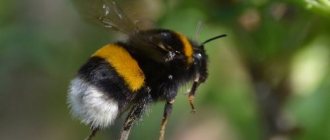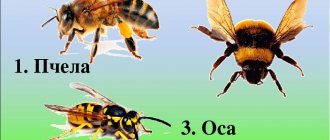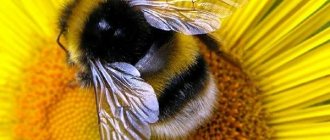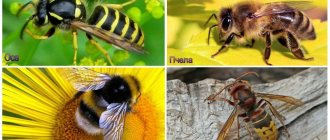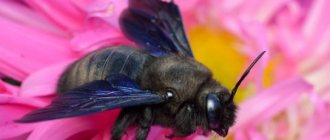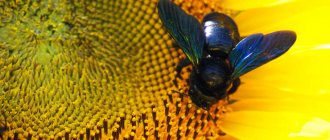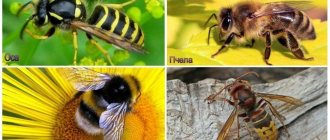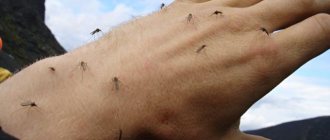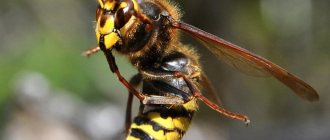- What do bumblebees eat?
The name of our today's hero - the bumblebee - came about thanks to the sounds that it usually makes during the flight, such buzzing, wheezing, from them came the ancient Russian word “chmel”, which over time transformed into the familiar modern “bumblebee”. By the way, the name of another well-known flyer was formed in a similar way -
mosquito But back to bumblebees, scientifically speaking, a bumblebee is an arthropod insect and belongs to the subclass of winged insects, the family of true bees, the genus of bumblebees proper (Bombus in Latin).
Description
Bumblebees belong to the class of arthropod winged insects and are a type of bee. The original name of the genus in Latin is “Bombus”. Creatures are widespread on Earth, living in all corners of the planet where there are suitable living conditions. Now zoologists know about 300 different varieties of insects, which belong to fifty subspecies.
The two most common types of bumblebees are Bombus terrestris and Bombus lapidarius. They live in most countries.
Back view of bumblebee
You can distinguish a bumblebee from other bees by its large size and rounded contours of its body. Thanks to the hairs on their body, they adapt well to cold climates and do not freeze. They are also considered warm-blooded insects. When moving quickly, their body begins to generate heat, and the internal temperature can reach forty degrees.
People have a stereotype that a bumblebee bite is very painful, and in general it is better to beware of insects.
Such fears arose due to the large size of the creature and powerful jaws. However, in fact, this type of bee is the most peaceful and harmless. Interesting fact : the sting of a bumblebee is smooth and does not have serrations, unlike a bee's.
If the latter retains it in the victim, then the bumblebee, having made a bite, can pull it back into the body and fly away. Bumblebees never attack first. They do not use their jaws as weapons, despite their power, and their only defense is their stinger. But the individual will use it if there is no other way out. Moreover, only females and insects that build a hive have it. Ordinary males do not have a sting and are almost completely defenseless. In nature, the bumblebee brings great benefits by pollinating a large number of flowers.
Which bumblebees do not build nests and do not collect nectar?
Not all bumblebees have exemplary families, the representatives of which perform the functions assigned to them. There are so-called cuckoo bumblebees (also known as parasitic bumblebees or whisperers) (lat. Psithyrus), which belong to the subgenus of social parasites from the genus of bumblebees and include 29 species. These lazy people do not build their own nests and do not collect nectar. Each of the parasitic species, as a rule, looks very similar to its host. Female cuckoo bumblebees can sometimes be distinguished only by the absence of pollen-collecting devices (brushes and baskets) on their legs. A female cuckoo enters a bumblebee's nest and lays eggs. Worker bumblebees feed the larvae as if they were their own. Therefore, cuckoo bumblebees do not need workers. Some species of cuckoo bumblebees, such as Bombus Rupestris, Bombus campestris, Bombus barbutellus, Bombus quadricolor, parasitize several species of bumblebees. Some species of parasitic bumblebees have only one host: for example, Bombus bohemicus chooses the burrow bumblebee (lat. Bombus lucorum) as its host. Having penetrated the host's nest, cuckoo bumblebees behave differently: some species are aggressive, they kill the queen and guards, others coexist for some time.
Photo credit: Alvesgaspar, CC BY-SA 3.0
Appearance and features
Yellow pollen on the black stripes of a bumblebee
A bumblebee has a massive body compared to other bees. Impressive dimensions are achieved due to developed pectoral muscles. They also serve as an additional source of heat along with the fluff. In cool weather, the insect begins to intensively contract its muscles, thereby increasing body temperature. This helps to warm up the body and go to pollinate flowers earlier than other types of bees.
On the sides of the body there are three pairs of limbs: two small legs in front and four large ones coming from the center. Bumblebees fly thanks to two wings located on the front of the body.
Bumblebees are black in color, with two yellow stripes on top: at the head and under the wings. There is also a white stripe in the sting area. The entire body is covered with small hairs, which determine the color pattern.
The head is quite small in relation to the body. At the top there are two long antennae planted next to the eyes. In front there is a powerful jaw, inside of which a long tongue is hidden.
Depending on the type, the insect can be of different sizes. Steppe bumblebees are the largest and can grow up to 3.5 cm in length. In common species, males reach up to 2.5 cm. Females are larger: their length reaches 2.9 cm. The body weight of males does not exceed 0.6 g , but for women it often exceeds 0.8 g.
Sex differences
The female's head has a slightly elongated shape and is somewhat rounded at the back of the head. As for males, their heads are almost round or triangular. In addition, in males you can see a dotted line that runs along the front and crown. Females also differ in that their upper lip is rectangular in shape and has strongly curved mandibles that overlap when closed. Males have quite powerful mouthparts that allow them to gnaw through the stems of blades of grass.
In females, regardless of the species, the sixth sternite is without characteristic ridges, and in males there is no median eminence on the second sternite. The abdomen of females always ends with a multiple action sting. This means that it does not have the characteristic barbs like a bee, and the female can easily pull it out of the victim’s body after a sting. As for the males, they do not have a stinger, which means that males do not bite. Instead of a sting, males have genitals in this place, well covered with a chitinous layer of a dark brown hue.
Males do not have baskets on their hind legs that serve to collect pollen, but they have maximum pubescence, the degree of which depends on the type of insect.
It is important to know! Female insects are divided into 2 categories: workers, who are busy collecting pollen, or queens, who are busy reproducing the family.
The Secret Life of Bumblebees
Where does the bumblebee live?
Habitat of bumblebees
Due to their good adaptation to environmental conditions, bumblebees live in almost all corners of the planet. Exceptions are places where there is very little vegetation, as well as in hot climates. At high temperatures, the insect begins to feel uncomfortable due to the fact that its body already generates a lot of heat during activities.
In some places the number of bumblebees is small. For example, the Arctic Circle is home to small populations of individual species adapted to cold climates and capable of pollinating local vegetation. In Greenland, Alaska and Chukotka they can only be found in alpine meadows. Small populations also occur in lands with a tropical climate.
Interesting fact : in some countries, gardeners specially breed garden bumblebees to increase productivity.
Most species of bumblebees live in Russia, Europe, Asia and America. They enjoy the local climate and abundant vegetation. Not so long ago, insects were specially brought to Australia, to the state of Tasmania. There they are used to increase the yield of clover, and bumblebees cope with their task with five points. And their peacefulness simplifies the process of using them.
Interesting: Bee: description, reproduction, lifestyle, habitat, nutrition, enemies, how honey is made, interesting facts
Tireless workers
Bumblebees work flawlessly in any weather. Where they do this, the tomato yield increases by a third due to additional pollination. The fact is that tomatoes and other nightshades are not very interesting for bees. For natural pollination of these crops, especially if they grow in a glass greenhouse, it is difficult to do without bumblebees. The effect of their action can be even greater under films. Here, bumblebees outperform bees on cucumbers, as they continue to work even in low light and extreme temperatures. Bumblebees fly from dawn to dusk. The most intense is before lunch. They don't care about light rain. Caring for the offspring is above all else. Another advantage over bees is a shorter flight radius. Garden bumblebees do not fly to surrounding fields, preferring to work near the house. If they choose some greenhouse as an apiary, then even in the heat there will not be a single barren flower on the tomato bushes. Also in the cucumber rows. Already at dawn, bumblebees will collect nectar and pollen, pollinating flowers at temperatures from 10 (while bees begin to fly only at 14) to 32-35 degrees, that is, all the time while the pollen is still viable. This wide temperature range is very important, since the quality of pollen also depends on humidity. If it drops below 40 percent, the pollen dries out, losing its ability to pollinate. At humidity levels above 70%, pollen sticks together and ovaries do not form. Unlike bees, bumblebees navigate well in a confined space and do not hit film or glass in a greenhouse. They are less sensitive to lack of light, and therefore pollinate well even in cloudy weather. The efficiency of bumblebees remains high even after opening the windows to ventilate the greenhouse, while bees usually leave it in search of other, more attractive sources of nectar. The effectiveness of pollination by bumblebees is checked by examining open and already closed flowers. All closed flowers should have numerous stings. Open flowers that are more than one day old should ideally have two to five stings. If this number does not exceed one or two, next season you should try to increase the number of bumblebees in the greenhouse. They usually begin to attract them in the spring. A little thick sugar syrup is poured into a small jar (for example, baby food), closed with a lid, in the center of which a hole is made and a wick is inserted. Cut out some bright flower from paper and glue it to the lid (with the same sugar syrup). The queen bumblebee must covet such a treat. Later, working bumblebees will also be attracted to the decoy. Having become accustomed to flying to the greenhouse every day in the spring for a treat, they will do this until the fall, that is, the entire pollination season. Typically, flowers in a greenhouse are inspected once every two days, checking the number of bites. Pollinated tomato flowers have external differences: their petals are directed back, and on the flower itself you can see traces of a bumblebee's jaws - darkened dots or stripes. The flower remains open for 2-3 days and must be pollinated before closing. If greenhouses use supplemental lighting (which often happens in spring and autumn), pollinators may have problems with orientation. The same thing sometimes happens in film greenhouses. This is due to the fact that bumblebees use the blue spectrum of light for orientation, and with additional lighting there is not enough of it. Greenhouse film also does not transmit enough blue spectrum light. In order for bumblebees to travel well from the house to the plants and back, it is better to install additional blue LED strips
It is important that they are in the same position all the time. Then the bumblebees will be able to navigate easily
Habitat and lifestyle of bumblebees
Bumblebees settle where the plants they are interested in grow.
Since several hundred species of bumblebees live on Earth, each has certain characteristics depending on environmental conditions and habits.
Bombus terrestris lives in Africa. It is black in color with small white spots on its belly. These bumblebees build their hives in the ground; this is done by the workers.
Bombus lapidarius is common in Europe. On its black body there are red-orange stripes, by which it is easy to distinguish it from other representatives of bees. If the African type of insects grows up to three centimeters, then this one is usually no more than two in length. They build their nests on rocks. This species is also characterized by cannibalism: females often feed males to their larvae.
A bumblebee collects pollen and nectar using its proboscis
Regardless of the species, bumblebees live in flocks and have a clear division into roles: queen, males and workers. The queen actively participates in the life of the nest and gives birth to offspring. Males and workers are engaged in approximately the same activities, but the former pay more attention to pollinating flowers, the latter - to expanding and strengthening the house. While bees try to carefully design the nest, planning entrances and internal structure, bumblebees often neglect this. Their houses look shapeless, as if they were made in haste. The material used is fur and wax, which are simply piled up and tunnels are dug inside.
Interesting fact : in order not to build a nest, bumblebees can occupy a mouse hole, driving out the previous occupant.
Bumblebees are very hardworking and go out every day to pollinate flowers. At the beginning of the day, the queen climbs onto the roof of the nest and begins to make loud sounds, thereby awakening all members of the flock from sleep. Having woken up, the insects go to work.
Making a house for bumblebees with your own hands
A bumblebee house is often made from improvised materials, because the finished product is not particularly complex in design. In most cases, this is a regular wooden box with some additional elements to ensure the bees' comfort. The method for making such a hive is presented below.
Required materials and tools
To create the six simplest designs you will need:
- rough boards, the thickness of which reaches from 2.5 cm to 3 m;
- cut from centimeter plywood 15x15 cm - 2 pieces;
- strips with a cross section of 1.5×1.5 cm - 4 pieces;
- drill;
- insulation material in the form of tow or moss;
- a piece of foam plastic measuring 15x15 cm.
Instead of the specified insulating material, other varieties with the same properties can be prepared. The sizes of bumblebees may also differ, but then the specified amount of material will be enough for fewer boxes.
Find out what to do if you are stung by a bumblebee.
Step-by-step instruction
The process of making hives using these materials involves the following steps:
- To begin, cut the prepared boards and put them together into a box 15x15x15 cm.
- Nail the bottom from cut plywood to the structure, and attach 4 strips to another similar part to form a “overlap” lid.
- In the front wall of the hive (approximately in the middle), drill 2 holes with a diameter of 1.8 cm each. Leave one open, and make the other blind by sealing it with a cork.
- Insulate the interior space with moss or tow, filling 1/3 of the entire volume of the box with it.
- Place the cut piece of foam plastic under the bottom of the bumblebee house.
Ready-made hives can be placed on 30-centimeter stakes and placed in the garden next to flowering plants in early May. In this case, the holes of the tapholes should “look” at the southern part of the site.
Important! Captured females (they are larger than males) are placed in such hives, and then the entrances are closed for a day. If they like the place, they will soon bring the rest of the family members, otherwise they will have to look for other individuals
What does a bumblebee eat?
Clover is the favorite delicacy of bumblebees.
Perhaps these creatures are the most finicky of the bee order in terms of food. If wasps can eat jam, honey, tree sap and other sweets, then bumblebees have only pollen and nectar in their diet. However, the list of plants from which they collect food is very long. They pollinate almost all flowers that grow in their habitats. It is often used in gardening. If a beehive has appeared next to the garden, there is no doubt that in the near future there will be a large harvest in the garden beds.
The larvae also need food, so upon returning to the nest, individuals try to bring as much nectar as possible, which serves as food for future offspring. If necessary, the cubs are also fed home-produced honey.
The bumblebee's favorite flower is clover. He is attracted by the smell and color of the plant, and as he flies past he cannot resist. It has also been noticed that bumblebees, just like other bees, are more willing to sit on bright buds than on those that have faded colors. However, if there is no other vegetation nearby, the insect will not hesitate to land on them.
Nutrition
In the vast majority of cases, the bumblebee eats nectar from clover - this is his favorite treat. But, in the absence of other food, it can fly to other flowers. Bumblebees collect their food at different times of the day. But if the weather is relatively hot, then they prefer the morning or evening hours, when the temperature drops a little.
Here's what this insect eats:
- Plant juice.
- Tree sap.
- In the larval stage - exclusively honey and nectar collected by their older brothers.
Character traits
Bumblebees are friendly and peaceful animals.
Bumblebees live in small flocks. Often the total number of individuals does not exceed hundreds. They are divided into large queens, responsible for the production of offspring, into males, and into small worker insects. Despite the developed social structure, the individual is not attached to the nest and at a certain moment may not return to it and find a new home, joining another flock. Moreover, this is mainly done by males who have already helped females with the production of offspring.
Interesting: Spiders
